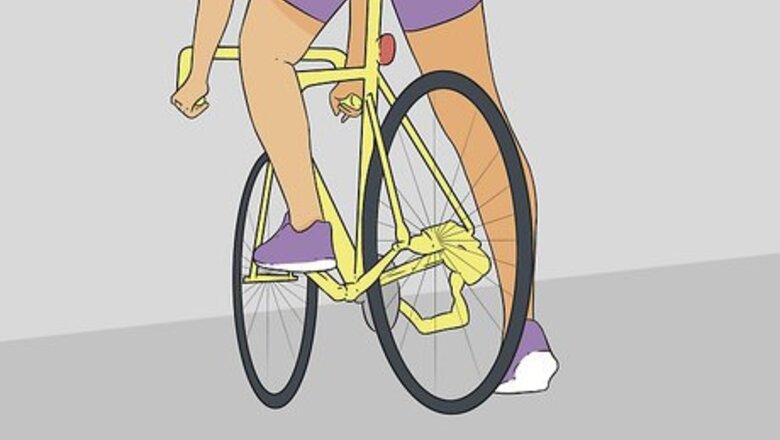
views
X
Research source
You can also use yoga to increase the flexibility in your quads, which can make them less prone to injury.
Warming Up Your Quads
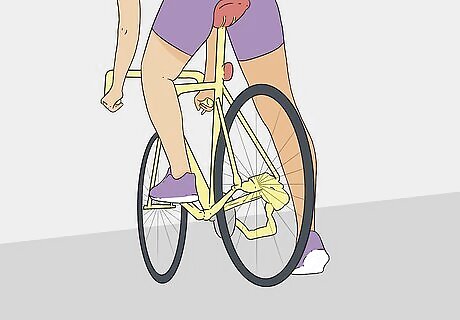
Walk or bike for 10 to 15 minutes. A gentle cardio exercise such as walking or biking will get the blood flowing to your quads and make stretching more comfortable. Stretching cold muscles could result in injury. If you're planning on exercising outside in cooler weather, add 5 to 10 minutes to your warm-up time before you start stretching.
Do standing quad stretches before a long run. From a standing position with your knees together, lift one foot and grasp it with your hand. Gently press your foot towards your glutes until you feel a stretch along the front of your thigh. Hold for 10 to 20 seconds, then repeat with the other foot. This stretch can be done both before and after a long run or other physical activity, as part of your warm-up or cool-down. You can also do this stretch while lying on one side. Brace your core to keep your spine in alignment and help stabilize your pelvis.
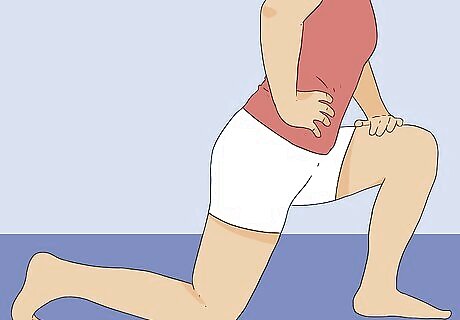
Add kneeling stretches to target quads and hip flexors. Kneel on the floor on one knee. You may want to rest your knee on a folded towel or mat. Lean forward slightly, with your other foot flat on the floor and your knees at right angles. Lean forward, contracting your core and the glute of the kneeling leg. As you exhale, shift your body forward to stretch your quad and other hip flexor muscles. You can rest your hands on your front thigh for balance and stability. Hold the stretch for a 15-40 seconds, then switch and repeat the stretch with the other leg. Keep your spine neutral and your upper body posture straight. You also want to avoid arching, rounding, or flattening your lower back or pulling back against the lean.
Use lunges for dynamic stretching. Stand with your feet a little wider than shoulder-width apart and step one foot forward. Lower your body by bending at the knees until the back knee is nearly at the floor. Your front knee should be in line with your ankle so that your shin is perpendicular to the floor. Raise up and repeat with the other side. You can do a series of lunges where you gradually move forward, or you can stay in the same place. Start with 2 sets of 10 repetitions on each leg. If you have trouble balancing and feel wobbly, place your hands on your hips or extend them out to form a T-shape.
Stretching Tight or Injured Quads
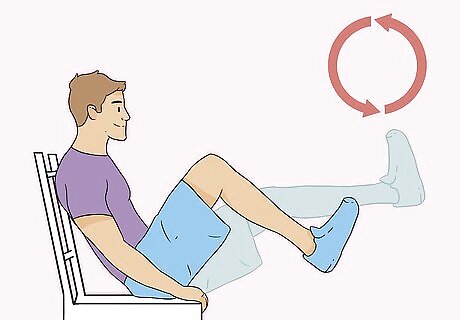
Use active range of motion exercises to maintain knee mobility. To complete this stretch, bend and straighten your knee through its full range of motion, or as far as you can go without discomfort. You can do this stretch while standing, sitting, or lying down. Choose the position that provides you the most stability and allows you to move your knee the most. This stretch is best soon after an injury, when your movement may be at its most limited. Try to complete 10 repetitions with each leg, but don't overdo it. Stop if you feel pain.
Find a partner for passive quad stretches. Either standing, sitting, or reclining, have your partner grasp your ankle or foot. Your partner will slowly bend and straighten your knee through its full range of motion. When your knee is fully bent, have them hold the stretch for a few seconds before slowly moving your foot back down. Passive quad stretches are a good way to stretch your quads if you don't have the control needed to do standing quad stretches on your own. If you're able to move on your own, passive quad stretches may be of little benefit to you. Communication is key with passive stretching. Don't let your partner push your leg to the point that you feel pain in the muscle. This could lead to additional tearing or re-injury.
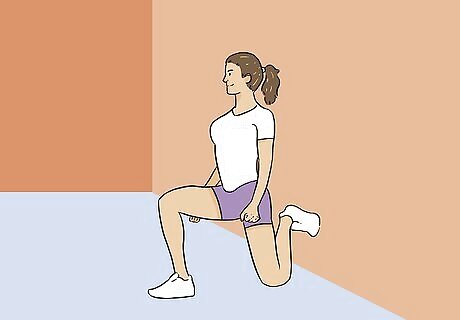
Relieve tightness with the couch stretch. Kneel with one knee on the ground in front of a couch. Brace the foot of your kneeling leg on the side of the couch. Your other leg should be straight out in front of you with your knee at a right angle and your shin perpendicular to the ground. Push your hips backward as you press your raised heel towards your glute. You can place your hands on your front knee for balance. Hold the stretch for a few seconds or breath cycles, then release and repeat the stretch with the other leg. In addition to a couch, you can also use a wall or low bench to lean your foot against.
Increase stability and control with supine squats. You will need a stability ball for this exercise. Sit on the ball, then walk your feet forward as you gradually lean back at the same time. When you are lying face up, roll forward and allow your knees to move over your toes until your knees are fully flexed. Then contract your quads and roll back until your knees are at 90-degree angles. Try to do 10 repetitions of this exercise. Only go as far as you can without pain or discomfort.
Improving Quad Flexibility
Lengthen your quads with the crescent lunge. From a standing position, step one foot forward and fold over so that your hands are on either side of your foot. Your front knee should be at a right angle with your shin perpendicular to the floor. Raise up on an inhale, sweeping your arms out to the side and overhead. Lower your hips and press downward into the lunge, stretching and lengthening your quads. Breathe deeply and hold the lunge for 30 seconds to a minute. To get out of the pose, lower your hands over your front leg and then walk or jump your front leg back to meet the other leg. You can raise your hips into downward facing dog if you like, then walk or jump the other leg to the front and repeat the lunge on the other side.
Lower into hero pose. Kneel on the floor, touching your inner knees together. Your feet should be slightly wider than your hips with the tops of your feet on the floor. Exhale and lower your hips onto the floor between your feet until your buttocks are resting comfortably on the floor. Lean forward slightly as you lower, wedging your thumbs into the backs of your knees. Breathe deeply, feeling the stretch in your quads, for 30 seconds to a minute. Open your shoulders and drop your shoulder blades down alongside your spine. If you can't sit comfortably on the floor in this position, place a block to sit on, or roll up a blanket or towel.
Stretch your thighs and core with bow pose. Lie face-down on your mat with your arms by your sides, palms up. On an exhale, bend your knees and raise your feet towards your buttocks. Reach back and grab either your ankles or the tops of your feet and pull them forward. As you inhale, lift your feet towards the ceiling as you raise your thighs off the floor. Breathing can be difficult in this position, but gaze forward and focus on breathing as deeply as you can. Hold the pose for 20 to 30 seconds, then slowly release to lay back down. You can use a folded blanket to pad your ribs and hips to make the pose more comfortable.
Open your hip flexors with pigeon pose. Start on all fours with your knees below your hips and wrists below your shoulders. Slide your right knee forward to the back of your right wrist as you pull your foot around to the left side. The side of your right shin should be lying on the mat perpendicular to your torso. Then slide your left leg back until it is flat on the floor. Exhale and raise up so you are in a sitting position with your right leg crossed in front of you and your left leg extending backwards. Hold the pose for 30 seconds to a minute, breathing deeply. Then return to all fours and repeat with your left leg in front and your right leg extended behind you. There are many variations to this pose. For example, try folding over your front leg and resting your chest and forehead on the mat for a more intense hip opener. For a really deep quad stretch, raise your back foot towards your buttocks. Grab your back foot or ankle with your hand and press it towards your buttocks to further deepen the stretch.
Bend into camel pose. Kneel with your legs about hip-width apart. Inhale and draw your elbows towards each other behind your body, allowing your sternum to lift and your rib cage to expand. Press your hands into your heels, maintaining the lifting in your sternum and keeping your shoulders back. Hold the stretch for 30 seconds to a minute, breathing deeply. Avoid tightening your glutes. Camel pose helps lengthen and improve flexibility in your hip flexors and upper quads. If it is too much of a challenge for you to reach your heels, you might place a block between your feet or lean back over an exercise ball.
Extend your backbend with little thunderbolt pose. Once you're comfortable in camel pose, take it a step further by lowering your head until the crown of your head rests between your feet. Reach your arms forward to grasp your lower thighs. Hold the pose for 30 seconds to a minute, breathing deeply. To come out of the pose, engage the core and slowly roll yourself back up to a kneeling position. Keep your glutes soft to avoid excess pressure on your lower back. This pose opens up your hips and quads. The practice of lifting up with your chest as you lower your torso backwards is an intense workout for your thighs.
Rest in child's pose. Still in a kneeling position, spread your knees slightly and bring your big toes together. On an exhale, fold over your thighs, extending your arms out overhead and resting your forehead on the floor. Breathe deeply in this position for as long as you want. In addition to being a relaxing way to end your practice, child's pose also works as a good counter-pose after backbends.

















Comments
0 comment